Creating a thriving environment in your aquarium involves careful management of various factors. One of the most crucial is water flow. In this article, we will explore how to slow the flow in your aquarium. This ensures the health and well-being of your aquatic life.
Proper aquarium flow control is essential for both fish and plant life. We’ll discuss effective strategies for reducing water flow in your fish tank. This sets the foundation for a harmonious aquatic ecosystem.
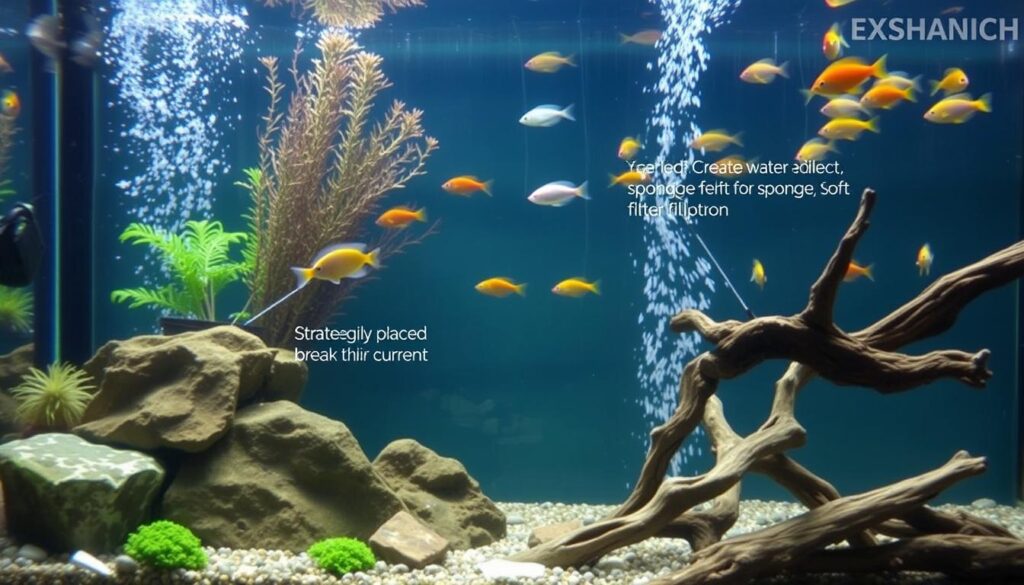
Understanding Water Flow in Aquariums
Knowing how water flows in aquariums is key to a healthy aquatic home. Water flow helps keep fish and plants healthy by controlling oxygen, nutrients, and waste. By managing water flow, we keep these important factors at their best, helping our aquatic friends stay well.
Importance of Water Flow for Aquatic Life
Water flow is crucial for an aquarium’s health. The right flow rate helps with gas exchange and keeps water oxygen-rich. It also spreads nutrients and removes toxins and waste. By learning to reduce water flow, we help our aquatic friends thrive.
How Water Flow Affects Fish Behavior
Different fish react differently to water flow. Some like calm waters, while others do well in strong currents. Managing water flow affects fish stress and activity. For example, too much flow can stress out some fish, making them sick or less active. But fish that love fast currents will do great.
Knowing what each fish likes helps us control water flow better. This way, we can make sure our fish are happy and healthy.
How to Slow the Flow in Your Aquarium
Creating a great home for your fish and plants means knowing the value of reducing water flow rates in aquarium. This part explains why it’s key to slow down the water flow in fish tanks. It helps certain fish and plants live better. Knowing where the water flows too fast lets you make smart changes.
Benefits of Reduced Water Flow
Less water flow is good for fish and plants. Here’s why:
- It makes a calm place for shy fish like bettas and some cichlids.
- It helps plants grow better because they like calm water.
- It makes fish less stressed, leading to healthier tanks.
- It keeps the bottom of the tank still, which is good for helpful bacteria.
Identifying High Flow Areas in Your Tank
Knowing where the water flows too fast helps you make better changes. Here are some tips:
- Look at the substrate; if it moves a lot, the flow is high.
- See how plants and decorations move; if they move a lot, the flow is strong.
- Use floating plants to slow down the water on the surface. They also give shy fish a safe place.
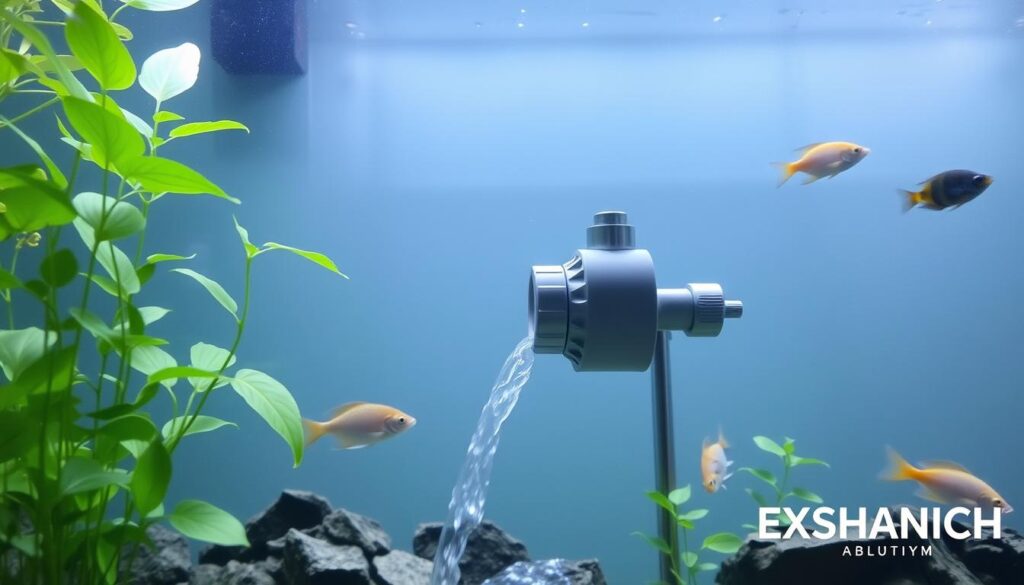
By working on minimizing water flow in fish tank setups and finding high flow spots, you can make a perfect home for your fish and plants. This way, you create a peaceful place for them to thrive.
Adjusting Aquarium Filter Flow
Knowing the types of filters for aquariums is key for good water flow. Filters like canister, hang-on-back, and internal types have different flow rates. This affects water movement in your tank. Understanding these factors helps adjust the filter flow for your tank’s needs.
Types of Filters and Their Flow Rates
Filters vary in flow rates. Here’s a quick look at common filter types and their flow rates:
| Filter Type | Flow Rate (GPH) | Best For |
|---|---|---|
| Canister Filter | 100 – 400 | Large aquariums, multi-stage filtration |
| Hang-On-Back Filter | 50 – 300 | Medium-sized tanks, simple maintenance |
| Internal Filter | 50 – 200 | Small aquariums, aesthetic setups |
Tips for Reducing Flow from Your Filter
Want to adjust your filter’s flow? Here are some tips:
- Adjust the filter’s intake height to lower the flow rate.
- Modify flow rate settings if the filter offers this feature.
- Use filter sponges to diffuse the output and reduce intense currents.
- Install baffles to redirect water movement in a gentler manner.
These tips can make your fish more comfortable. They help create a peaceful aquatic home.
Using Flow Control Devices
Flow control devices are key in managing water flow in aquariums. They help create a balanced environment for fish and plants by reducing strong currents. By using specific devices for fish tanks, you can greatly improve your aquatic friends’ living conditions.
Types of Flow Regulators Available
There are many types of aquarium flow regulators, each with its own function. Here are some common ones:
- Valves: Used to adjust the flow rate by restricting how much water can pass through a pipe.
- Flow Restrictors: Ideal for fine-tuning water flow, these devices limit water passage in a controlled manner.
- Splittable Hoses: Allow you to split water flow into multiple directions, helping to distribute it evenly.
How to Install a Flow Control Device
Installing a flow control device might seem hard, but it’s easy with a few steps:
- Turn off all equipment and ensure that the aquarium is safe to work on.
- Select the right flow control device suitable for your aquarium’s needs.
- Carefully remove the section of tubing or piping where the device will be installed.
- Install the flow control device according to the manufacturer’s instructions, ensuring it fits securely.
- Reconnect the tubing and turn on the equipment to test the flow rate.
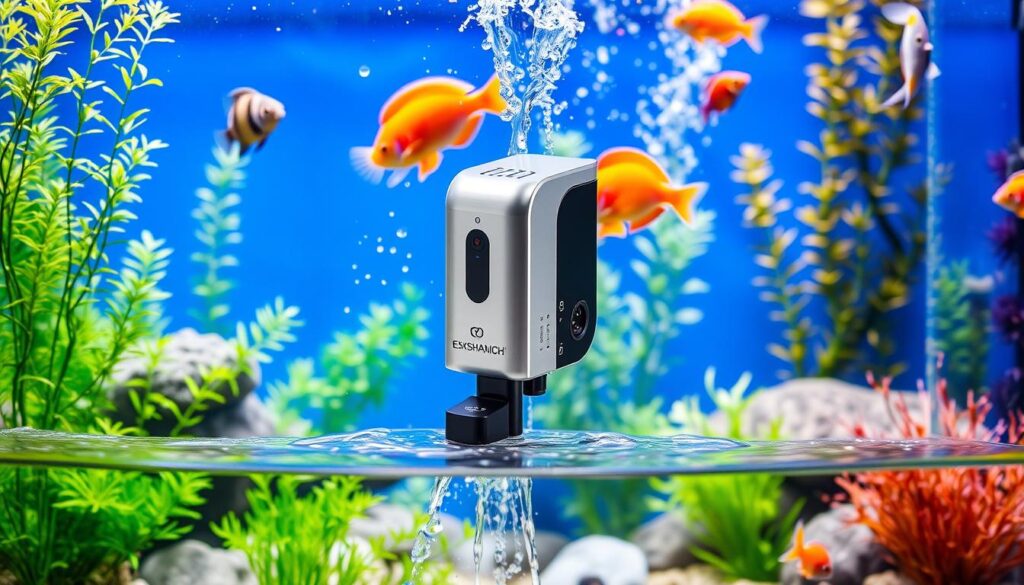
Proper installation of flow control devices ensures stable conditions in your aquarium. It not only benefits fish but also helps maintain a thriving aquatic ecosystem. Adding flow control devices can create an ideal environment in your aquarium.
| Flow Control Device | Function | Benefits |
|---|---|---|
| Valves | Adjusts flow rate | Easy control over water circulation |
| Flow Restrictors | Limits water passage | Precise flow adjustments |
| Splittable Hoses | Distributes flow | Even flow distribution to multiple areas |
Altering Water Pump Settings
Choosing the right water pump is key for a balanced aquarium. Tank size and the needs of your fish and plants matter a lot. Look for pumps that let you adjust water pump flow rates. This helps in reducing water flow, making sure your fish and plants do well.
Choosing the Right Water Pump for Your Aquarium
When picking a water pump, think about these important features:
- Flow Rate: Make sure the pump can be adjusted to fit your aquarium’s needs.
- Size: The pump should fit well in your tank and work well.
- Noise Level: Choose quieter pumps for a peaceful tank.
- Energy Efficiency: Opt for pumps that save energy to cut costs.
Steps to Adjust Water Pump Flow Rates
To keep your aquarium healthy, follow these steps to adjust water pump flow rates:
- Slowly change the pump’s flow setting by small amounts.
- Watch how your fish and plants react to each change.
- Give them time to get used to the new flow rate before making more changes.
- Keep track of your flow settings and changes. This helps manage your aquarium pump’s water flow.
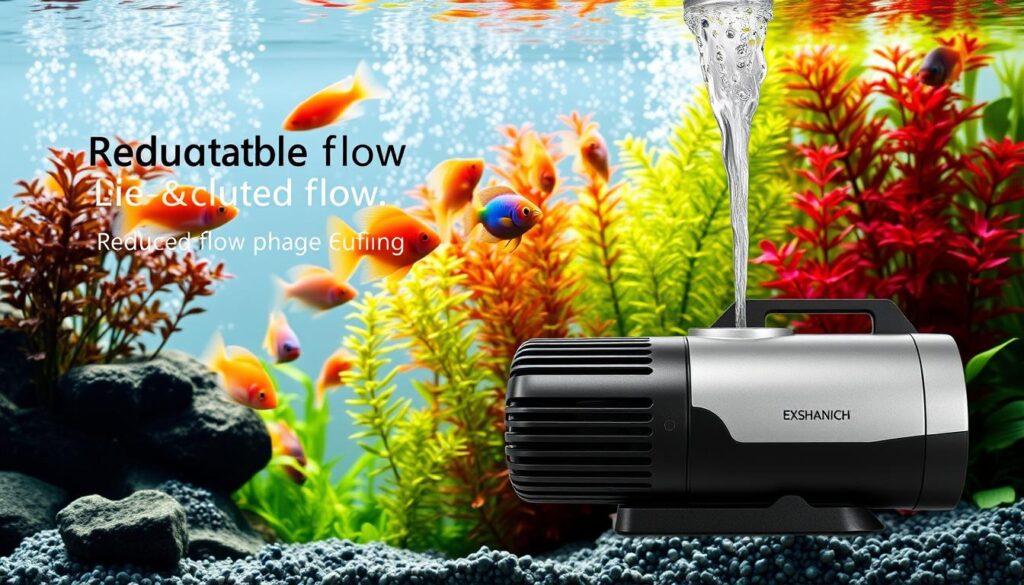
Creating Flow Obstacles in Your Aquarium
Managing water flow in aquariums is key. Decorations and plants do more than look good. They also slow down water flow by acting as natural barriers. By picking the right decorations, you can make your aquarium a better place for fish.
Using Decorations and Plants to Slow Down Flow
Decorations like driftwood, rocks, and dense plants can slow down water flow. They also create hiding spots for fish. Here are some great options:
- Driftwood – Adds natural texture and disrupts flow.
- Rocks – Create pathways and hideouts, breaking the water path.
- Densely Planted Areas – Offer refuge and reduce velocity significantly.
Best Practices for Arranging Aquascapes
To make your decorations work best, follow these tips:
- Put big decorations where they can block the current.
- Group plants to make a wall that changes water direction.
- Keep some areas open for gentle flow, but not too still.
Try different setups to find the best flow balance for your aquarium. The goal is to make a cozy space for your fish.
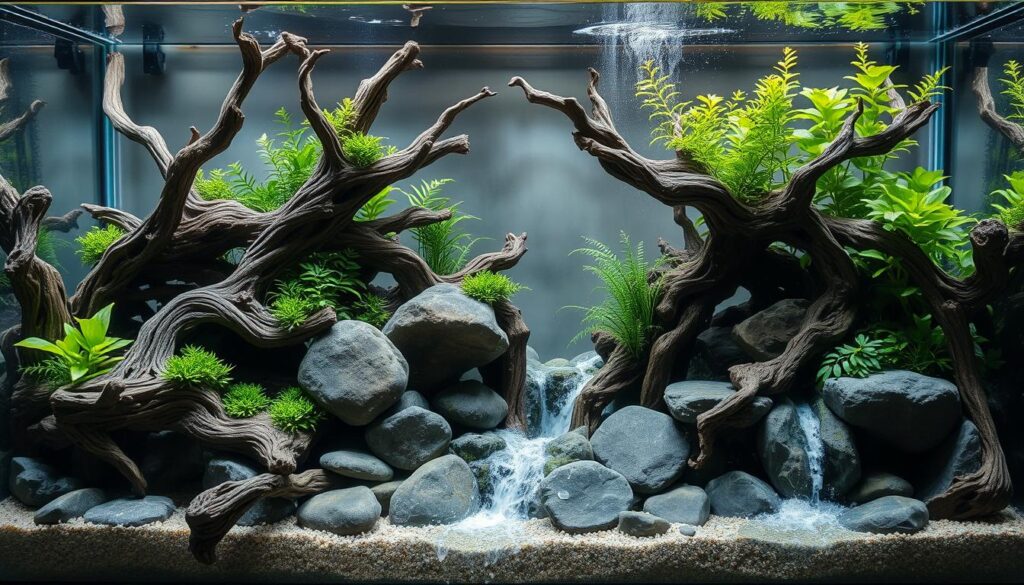
| Decoration Type | Flow Reduction Effectiveness | Visual Appeal |
|---|---|---|
| Driftwood | High | Natural |
| Rocks | Medium | Varied |
| Dense Plants | Very High | Lush |
Controlling Water Movement with Surface Agitation
Surface agitation in your aquarium is key to controlling water movement. It helps with oxygen exchange, evaporation, and keeps aquatic life healthy. Learning to manage surface agitation is crucial for a better environment for fish and plants.
How Surface Agitation Affects Flow Dynamics
Surface agitation helps distribute oxygen in the water. This is vital for fish to breathe and stay healthy. But too much agitation can stress fish. It’s important to keep an eye on surface conditions and how they affect water flow.
Techniques for Reducing Surface Current
To control surface agitation and reduce current, try these methods:
- Adjusting the filter output can minimize strong currents while maintaining adequate oxygen flow.
- Utilizing debris-free filter media can enhance filtration without disrupting surface movement.
- Arranging decorations and plants near the water surface may create natural barriers that diffuse strong currents.
- Implementing surface skimmers can also assist in controlling water movement, allowing for cleaner water without causing extreme agitation.
| Technique | Description | Effect on Flow |
|---|---|---|
| Adjusting Filter Output | Change the angle or height of the output. | Reduces direct water flow towards fish. |
| Debris-Free Media | Using media that does not create extra turbulence. | Minimizes surface current and improves clarity. |
| Decorations | Positioning items strategically for flow diffusion. | Creates calm areas enhancing fish comfort. |
| Surface Skimmers | Devices designed to remove debris at the water’s surface. | Improves cleanliness without increasing agitation. |
Monitoring and Maintaining Optimal Water Flow
Keeping the right water flow is key for a healthy aquarium. It makes sure oxygen gets around and waste is removed. Good water circulation tips help keep fish and plants healthy.
Tools for Measuring Water Flow Rates
Using tools to check water flow in fish tanks is important. It helps see if your filter is working well. Here are some common tools:
- Flow Meters: These tools measure how fast water flows in gallons per hour. You can put them in your plumbing system.
- Current Indicators: These show you how fast the water is moving in the tank. They help spot strong currents.
- Hydrometers: Used mostly in saltwater tanks, hydrometers help see changes in water density. This can happen when flow changes.
Regular Maintenance Tips for Your Aquarium
Keeping up with regular maintenance is crucial for your aquarium’s flow. Here are some tips:
- Clean your filters monthly to stop blockages that can mess with flow.
- Check for debris around pumps and intakes now and then.
- Change the layout of decorations and plants every few months. This helps manage flow better.
- Look over and replace any worn or broken equipment. This keeps things running smoothly.
Conclusion
Managing water flow is key for your aquarium’s health and happiness. This article has shared practical ways to control water flow. These methods help both fish and plants thrive.
Adjusting filters, using flow control devices, or creative aquascaping are good options. The most important thing is to watch and adjust as needed. This keeps your tank’s environment balanced.
Every aquarium is different, so you’ll need to make changes often. By watching your fish and plants, you can create a perfect home for them. This will make your aquarium look great and keep your pets happy.
Slowing down water flow in your aquarium is a rewarding task. It makes your underwater world more vibrant and peaceful. Enjoy the process of caring for your aquarium and the joy it brings to you and your fish.
FAQ
How can I slow the flow in my aquarium?
To slow down the flow, adjust your filter settings. Use flow control devices like valves or flow regulators. Place decorations and plants to block the water path.
What are some tips for reducing water flow in my fish tank?
Use a lower flow filter to reduce water flow. Adjust the filter’s output direction. Employ sponges or baffles to slow down the flow.
Observe your tank to find high flow areas. Place plants or rocks there to redirect currents.
How does water flow affect my fish’s behavior?
Different fish species like different water flows. Some prefer calm water, while others like swift currents. High flow rates can stress shy fish.
This can affect their feeding and health. It’s important to understand your fish’s needs for their well-being.
What types of flow control devices are available for aquariums?
There are flow regulators, valves, and adjustable water pumps. These devices can limit water output and manage flow rate in your tank.
How can I adjust my aquarium filter flow?
Adjust your filter flow by changing its position or height. Use filter media like sponges to diffuse the output.
Some filters have built-in flow rate settings that you can modify.
Are there specific plants or decorations that can help slow down water flow?
Yes! Plants like Anubias or Java Fern can slow down water flow. They are dense and create resistance in the water.
Decorations such as driftwood or rocks can also disrupt the current. They create calmer areas for your fish.
How do I choose the right water pump for my aquarium?
Choose a water pump based on your aquarium’s size and desired flow rate. Look for pumps with adjustable settings.
This ensures a balanced environment for your aquatic life.
What maintenance tips can I follow to maintain optimal water flow?
Regularly check for blockages in your filter. Clean the pump and decorations. Reassess your tank’s layout.
Keeping an eye on water flow dynamics helps maintain your aquarium’s health.
How does surface agitation affect water flow in the aquarium?
Surface agitation is key for oxygen exchange and evaporation. Too much can disrupt calm areas, while too little can cause oxygen depletion.
Adjusting filter output and using the right filter media can help manage this balance.




 No products in the cart.
No products in the cart.